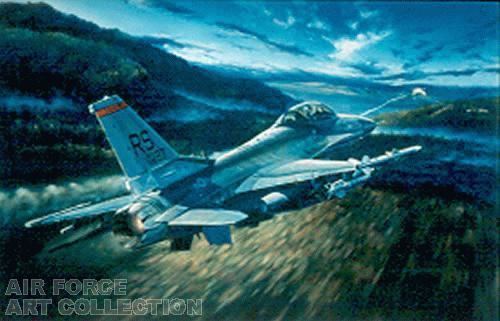Date 28 February 1994 | ||
 | ||
Similar Operation Tiger, Bosnian War, Siege of Bihać, Operation Sana, Siege of Mostar | ||
Banja luka incident
The Banja Luka incident on 28 February 1994, was an incident in which six Republika Srpska Air Force J-21 Jastreb single-seat light attack jets were engaged, and four of them shot down, by United States Air Force F-16 fighters southwest of Banja Luka, Bosnia and Herzegovina. It was the first active combat in NATO's history.
Contents
Bombing of Novi Travnik
In February 1994, the 526th Fighter Squadron, "Black Knights", based out of Ramstein AB, Germany, was attached to the 401st Operations Group (Provisional) operating out of Aviano AB, Italy, as part of NATO's Operation Deny Flight. On Feb 28th, a flight of two 526th F-16s, "Knight 25" and "Knight 26", were crossing over Croatian airspace to conduct Close Air Support training near Sarajevo, Bosnia, when they detected six unidentified radar contacts eastbound in the No Fly Zone. These contacts were not immediately visible to the NATO AWACS aircraft flying over Hungarian territory because of distance and hilly terrain. After several minutes, AWACS was able to establish contact south of Banja Luka at 6:35 a.m. Two other 526th Squadron F-16s, Black 03 and Black 04,were vectored to the area and intercepted six J-21 Jastreb and two J-22 Orao aircraft which were bombing the "Bratstvo" military factory at Novi Travnik.
In accordance with the UN and NATO rules of engagement, orders to "land or exit the no-fly zone or be engaged" were issued twice, but both warnings were ignored. While warnings were issued, the violating aircraft dropped bombs over their target, which was left in flames. In such circumstances NATO has a "single key", meaning that only one clearance was needed, so the Combined Air Operations Center was immediately able to clear the F-16s to attack.
Air engagement
The Bosnian Serb Jastrebs headed northwards, back to their base. At 6:45 a.m., the NATO fighters engaged their opponents. Captain Robert G. Wright fired an AIM-120 AMRAAM, downing the first Jastreb which was flying at 5,000 feet. The remaining Jastrebs dropped to a few hundred feet, flying at low level to use the mountainous terrain to hide from radar and make their escape back to Udbina. Wright pressed on, closing to within AIM-9 Sidewinder range. He fired two of his heat-seeking Sidewinder missiles, and they were seen to hit the Serb aircraft.
After he had expended all his missiles and low on fuel, Wright handed over the chase to his wingman, Capt. Scott O'Grady, who had been flying 'top cover' above his flight leader.
O'Grady dropped down to engage and fired an AIM-9M, the missile was locked on but a hit could not be confirmed. Black flight was now approaching "bingo fuel", the point at which a plane will not have enough fuel to return, so they pulled off to refuel from a KC-135 Stratotanker circling in orbit over the Adriatic. At the same time another pair of F-16Cs, "Knight 25" and "Knight 26", had been vectored to the area by the AWACS. At 6:50 a.m., "Knight 25", piloted by Capt. Steve "Yogi" Allen, managed to get in behind a single Jastreb flying at a very low altitude. He launched a Sidewinder, downing another J-21 Jastreb. Knight 25 flight turned back hard to the south, where Knight 26, Col John "Jace" Meyer, established radar lock on another aircraft egressing to the Northwest. After a minute of pursuit, radar contact was lost and the flight broke off the attack. Low on fuel, Knight 25 and 26 returned to the tanker over the Adriatic. After refueling, they resumed combat air patrol over Bosnia.
The remaining aircraft were able to land at Udbina Air Base in the Republic of Serbian Krajina in present-day Croatia.
The USAF credited three kills to Captain Robert Gordon "Wilbur" Wright, flying F-16C-40 #89-2137/RS, using an AIM-120 AMRAAM and two AIM-9 Sidewinders; and one kill using an AIM-9 Sidewinder to Captain Stephen L. "Yogi" Allen flying F-16C-40 #89-2009/RS of the same unit. The Serbs acknowledged the loss of five aircraft in the incident; the discrepancy probably stems from the fact that an additional aircraft crashed after being hit by a missile explosion while trying to escape in low-level flight.
This engagement was the first wartime action conducted by NATO forces since its formation in 1949.
Bosnian Serb pilots
The Bosnian Serb pilots involved in the incident were:
